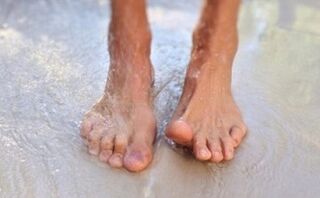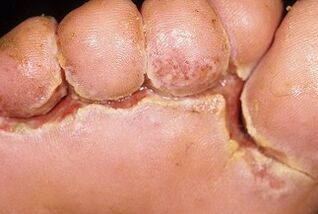About 80% of the population is affected by skin fungus. Due to increased density and sweating, mycoses are more likely to be exposed to the skin on the feet. Fungal infections are manifested by peeling and itching, but it can also be asymptomatic, causing only the appearance of seals (calluses, corns - hyperkeratosis on the heels and arches of the feet). If left untreated, the infection will spread. The patient can infect others, spreading the germs throughout his or her own body.
Where does the fungus come from

Fungal microorganisms love a humid and warm environment and plenty of nutrients. As a "shelter" they use thick skin, prone to increased secretion of fat and sweat.
Human feet - always act as a good breeding ground for mycobacteria, and low -quality socks and shoes contribute to this.
You can be infected in public places - on the beach, in the sauna, in the pool. You can carry an infection when trying on new shoes, because the day before, someone with foot mycosis was able to measure it.
Several internal factors also increase susceptibility to fungi:
- weakened immunity - fungi reject the body's defenses, when they are weak, microorganisms more easily penetrate the skin;
- endocrine disorders - diabetes mellitus and hormonal imbalances alter the composition of skin secretions, turning them into breeding grounds of bacteria;
- persistent injuries - cracks, crevices, scratches and punctures can be fungal entrances;
- lack of hygiene - poor quality foot washing, use of dirty socks and airtight shoes contribute to fungal attacks on limbs.
Infection may also occur from a loved one - if there is a patient at home or a carrier of the fungus with an asymptomatic disease. Disputes pathogenic microorganisms spread to household appliances, personal belongings, gender (if the patient moves barefoot). While washing the belongings of all occupants of the house, mycobacteria wear the clothes of healthy family members, they can provoke mycosis not only on the legs, but also on other parts of the body (in the folds, groin, in hairy areas of the body).
Why does fungus appear between the fingers
Interdigital fungus is a typical clinical form of foot mycosis. Doctors call it interconnected. With this course, the skin will be affected between 3 and 4 or 4 and 5 toes. Often, the pathological process begins in one limb, eventually spreading into a healthy limb.

Mycosis begins with a crack of the skin between the toes or at the base of the phalanx in the foot. The size of the injury can be from 2-3 mm to 1 cm. The intensity of symptoms depends on the area of the wound - the larger the injury, the stronger the pain. At the time of the appearance of cracks, the person experiences slight discomfort when walking, which increases with hygiene procedures.
Unlike other injuries, cracks do not heal on their own. It becomes inflamed, releasing exudates. The surface between the fingers becomes wet, which in turn contributes to the spread of the fungus to larger areas of skin. "Fringe" appeared around the wound - the skin was peeled with steam. The detachment was quite thick, attempts to remove it with fingers resulted in injury to healthy areas of skin. Persistent exfoliation appears around the lesion. It can be lamellar or mealy. The scales are silvery, white, yellowish. These characteristics depend on the strain of the fungus infecting the skin. Once the crack has healed, the original form of mycosis turns into squamous - it manifests itself as a large dry area on the foot, with many exfoliating scales. The surface may be shiny or resemble tissue.
What to do with fungal symptoms
If there is a crack between your fingers surrounded by loose skin, you must see a dermatologist. The specialist will perform an examination, determining the symptoms not only at the site of injury, but also on other parts of the body.
Diagnosis cannot be made based on symptoms alone. Microscopic examination of the skin scraping from the feet will be required to confirm the fungus. If there is resistant mycosis, it is complemented by PCR analysis or culture inoculation to determine the type of pathogen and its sensitivity to fungicide drugs.
In case of further fungus or extensive dermal lesions, systemic medication will be required. Due to the possible hepato- and nephrotoxic effects of such drugs, patients should undergo blood and urine tests. Based on the results, the specialist assesses the function of vital organs, selecting a treatment regimen with systemic antimycotics.
Self-medication for fungal infections of the feet is only allowed in the early stages. You can get it with topical medications that do not give systemic side effects.
An effective remedy against interdigital fungi
The characteristics of therapy depend on the individual data of the patient, the degree of mycosis, the area of the lesion, the presence of secondary infection or pathogen resistance.
Systemic medicine
To speed up treatment and complete it, doctors prescribe antifungal agents in the form of tablets or capsules.
While treating with systemic action drugs, it is undesirable to consume alcohol, fatty foods and other foods that place a burden on the liver. If the infection has spread to the nail from the interdigital space, longer use of antimycotics is required.
Local medicine
For the treatment of interdigital fungus, medications are prescribed in moderately oily or non-greasy (creams, solutions). The ointment can only be used in the early stages when skin softening is needed for rapid wound healing. Along the way, antifungal medications can be prescribed as healers and antiseptic agents. They speed up the regrowth process and also soften rough skin.
For the treatment of fungus on the feet, external agents with broad -spectrum fungicide components are prescribed. Suitable for products based on:
- terbinafine;
- clotrimazole;
- ketoconazole;
- econazole;
- naftifina.
Price does not affect the success of treatment, it is important to choose the right active ingredient of the drug.
Creams and solutions are applied to the skin 1-2 times a day after the hygiene procedure. Once processed, the product is allowed to fully absorb and wear cotton socks. In parallel, it is necessary to disinfect shoes every 3-7 days. For this, a fungicide spray is used. Change socks, underwear, towels are needed periodically. You should wash used items at high temperatures separately from the patient’s accessories and other family members.
With trichophytosis and microsporia, doctors recommend special treatment regimens. For example, treatment with iodine solution in the morning and sulfur, sulfur-tar or salicylic ointment in the evening.
Folk remedies
You can not be treated with fungus only by folk methods. Bathing is allowed in addition to medicine. If the doctor advises the use of homemade ointments or formulations, the drug should be used separately from pharmaceutical preparations. For example, in the morning and evening, use ready -made medicine, and in the evening - homemade ointment. The most popular methods of treating fungus among people:
- oak bark bath- make a large amount of broth from oak bark (6 tablespoons per 1 liter), dilute half with clean water, bathe for 15 minutes daily;
- with sea salt- prepare a strong solution of sea salt, bathe for 10 minutes, do not wash off the salt, wear cotton socks immediately after the procedure;
- with soda- dilute one tablespoon of soda in 1 liter of water, bathe for 15 minutes, after wiping, apply a pharmaceutical antifungal agent;
- egg ointment- 1 chicken egg mixed with one tablespoon of oil and vinegar, mixed until smooth, rubbed for 3-4 hours under the bag, washed down with water;
- the tree- the affected area of the fungus is lubricated profusely with essential oil of tea tree, washed after 3 hours, with sensitivity, the oil is diluted in half with neutral fat.
Rapid healing of the fungus is facilitated by the rejection of sweets, alcohol, fatty foods. The patient's diet should contain plenty of vegetables, fermented dairy products, whole grain cereals.
To prevent fungus on the feet and between the toes, you should keep your feet clean. When visiting any public place, avoid walking barefoot, use means to prevent fungus - antifungal ointment or spray applied after bathing. New shoes should be measured only with new socks; you cannot give your slippers to anyone.
























